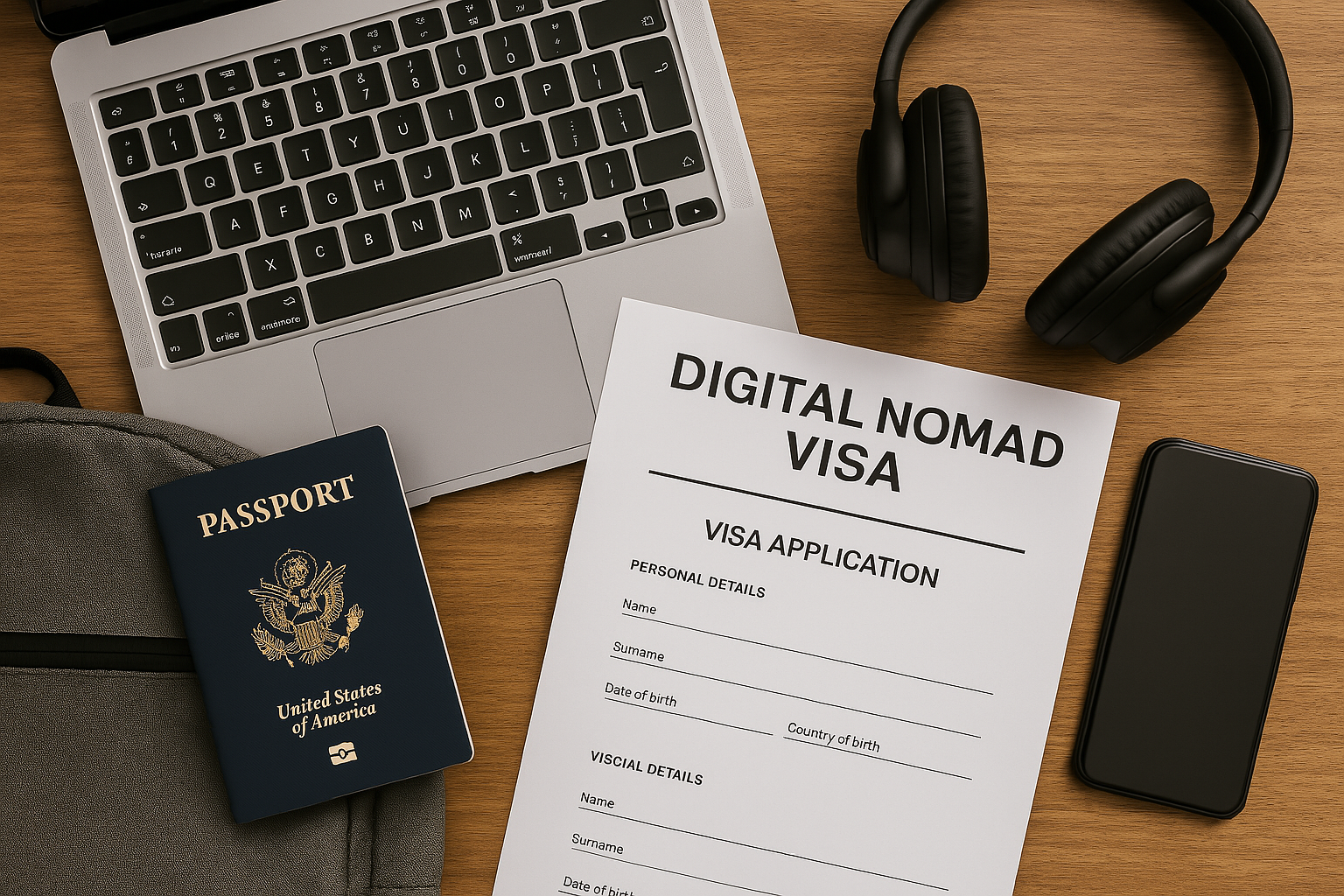I. Introduction
Remote work has exploded in popularity, and with it, a growing number of travelers want to stay abroad longer than the typical tourist visa allows. Enter the digital nomad visa: an official permit that lets freelancers and remote workers live in a country for months (or even years) without constantly renewing tourist status. This development is a huge relief for anyone tired of short stays, border runs, and uncertain legal situations.
In this article, we’ll explore what a digital nomad visa is, why countries offer it, and which places have the best programs—complete with official government links for further details. We’ll also walk through the steps to apply, practical living tips, and how to avoid pitfalls. If you’ve ever dreamed of settling into a new culture for more than a few weeks—while still earning an income from abroad—this is for you.
II. What Is a Digital Nomad Visa?
A. Definition & Basics
A digital nomad visa is a special permit that lets remote workers or freelancers legally reside in a foreign country for an extended period. Unlike a standard tourist visa that might cap stays at 30, 60, or 90 days, nomad visas often last for six months to two years. In many cases, you’ll have the ability to renew or extend your stay if you continue meeting the criteria.
B. Why It Exists
Many governments see the economic boost from remote workers who spend money on local housing, groceries, dining, and services. By offering a streamlined visa, they attract skilled individuals who inject money into the local economy without taking local jobs. That’s a win-win for both sides.
Some countries are focusing on building a reputation as tech-friendly hubs, hoping to draw in innovative people and potentially future investments or partnerships.

III. Key Benefits of a Digital Nomad Visa
A. Longer Stays
Most digital nomad visas let you stay anywhere from 6 months to 2 years—far beyond the usual tourist allowances. This means you can truly live in a place, build routines, and forge connections instead of rushing off every few weeks.
B. Fewer Legal Hurdles
If you’ve ever tried “slow traveling” with just tourist visas, you know the hassle: repeated border runs, tracking how many days you have left, or worrying about overstaying. A digital nomad visa keeps you on solid legal ground, so you can focus on working and enjoying your new environment.
C. Potential Tax & Financial Perks
Some digital nomad visas offer tax reductions or even exemptions, depending on your situation. Others might simplify the process of renting apartments or opening local bank accounts. Be sure to check each country’s rules, since tax policies vary widely.
D. Community & Networking
A solid number of these visa-friendly countries also have lively expat and digital nomad communities, along with co-working spaces. Making friends, swapping tips, or collaborating on projects is simpler when you’re settled for the long haul.
IV. Important Considerations Before Applying
A. Income Requirements
Many programs have a minimum monthly or yearly income threshold. Some ask for as low as $1,500/month, while others can require $3,000 or more. It’s a way to ensure you can support yourself and won’t job-hunt locally.
B. Tax Implications
Even if the host country offers friendly tax terms, you might still owe taxes in your home country or wherever you hold citizenship. Some governments want proof you pay taxes somewhere else (so you’re not using their country as a tax haven). Double-check everything to avoid big surprises.
C. Length of Stay & Renewals
Some digital nomad visas can be renewed multiple times, effectively letting you stay for years. Others might only allow a single extension—or none at all. Make sure you know how long you can remain, what renewal paperwork is involved, and how physically present you must be each year.
D. Documentation & Fees
Expect to show proof of health insurance, bank statements, remote work contracts or freelance income, and in some cases, a background check. Each country’s fee structure differs; some charge as little as $50 while others might push $1,000 or more.
E. Local Rules & Restrictions
Remember that a digital nomad visa usually prohibits local employment. You can’t take a job with a local company unless you switch to a different type of work permit. Also, some countries require you to register at a local municipality or immigration office once you arrive.
- Top Countries with Digital Nomad Visas

Below are some standout destinations offering official long-term visas for remote workers. Check the provided links for real-time updates, as requirements can evolve.
1. Estonia
- Visa Name: Digital Nomad Visa
- Duration: Up to 1 year
- Income Requirement: ~€3,504/month
- Highlights: Estonia is known for its advanced e-government systems. They even have an e-Residency program that allows business registration online.
- Official Link: Estonia Police and Border Guard Board
2. Portugal
- Visa Name: D7 Visa (often used by remote workers/freelancers) or the new Digital Nomad Visa
- Duration: 1 year initially, renewable up to 5 years
- Income Requirement: Approximately €700–€1,000/month (varies by region and visa type)
- Highlights: Low living costs outside big cities, warm culture, and strong expat hubs in Lisbon, Porto, and the Madeira islands.
- Official Link: Portuguese Immigration and Borders Service (SEF)
3. Spain
- Visa Name: New digital nomad visa launched in 2023
- Duration: 1 year initially, renewable up to 5 years
- Income Requirement: Around 200% of Spain’s minimum wage (~€2,334/month)
- Highlights: Spain has a fantastic mix of sunny coastlines, dynamic cities (Barcelona, Madrid), and deep cultural heritage.
- Official Link: Consulate of Spain or your local Spanish embassy for updates
4. Croatia
- Visa Name: Digital Nomad Residence Permit
- Duration: 1 year (non-renewable, but you may reapply after leaving for a set period)
- Income Requirement: ~€2,300/month
- Highlights: Croatia’s Adriatic coast is stunning, with countless islands, UNESCO sites, and relaxed Mediterranean vibes.
- Official Link: Croatian Ministry of Interior
5. Dubai (UAE)
- Visa Name: Virtual Working Program
- Duration: 1 year
- Income Requirement: ~$5,000/month
- Highlights: Modern amenities, robust infrastructure, and easy global flight connections make Dubai a strategic location for business.
- Official Link: Dubai Department of Economy & Tourism
6. Georgia
- Program: Remotely from Georgia
- Duration: Typically up to 1 year
- Income Requirement: ~$2,000/month
- Highlights: Affordable living, scenic Caucasus mountains, laid-back hospitality. Some aspects of the program may shift, so keep checking official sources.
- Official Link: Official Georgia Travel Site (Program details sometimes found under “Remotely from Georgia” or see local embassies)
7. Bali (Indonesia)
- Visa: Rumored digital nomad visa is in the works, but many rely on a Business Visa or Social Visa with strategic renewals.
- Duration: Varies; these are not strictly “nomad visas” but can last several months.
- Highlights: Vibrant community, low costs, incredible nature—but rules can be confusing. Possibly a new official nomad visa soon.
- Official Link: Indonesian Immigration (for updates on new visa policies)
8. Germany
- Visa Name: Freiberufler (Freelance) Visa or Aufenthaltserlaubnis für selbständige Tätigkeit
- Duration: Up to 3 years, renewable
- Income Requirement: Must demonstrate sufficient income for freelance living (varies).
- Highlights: A well-developed economy, top-notch infrastructure, and cultural variety. Some official processes might require German language.
- Official Link: German Federal Foreign Office (check details about freelance visas)
9. Mexico
- Visa Name: Temporary Resident Visa (adaptable for remote income)
- Duration: 1 year initially, can be renewed up to 4 years
- Income Requirement: ~US$1,620/month or certain savings thresholds
- Highlights: Diverse regions (beach towns, cultural hubs), active expat communities, and fairly straightforward application processes.
- Official Link: Instituto Nacional de Migración (Mexico)
(Feel free to add or remove countries based on preference, but these are solid examples.)
VI. Step-by-Step: How to Apply
- Research & Choose
- Reflect on your personal needs: climate, local language, living costs, etc.
- Compare official government pages to confirm current rules, as these can change quickly.
- Gather Documents
- Common needs: passport valid for 6+ months, proof of remote income, health insurance, background checks, and bank statements.
- Double-check each country’s official immigration site for specifics.
- Submit Application
- Some countries let you apply online, others require an in-person appointment at a consulate or embassy.
- Expect to pay an application fee that ranges from around $50 to $1,000+.
- Wait for Approval
- Processing times vary from a couple of weeks to a few months.
- Plan your travel dates carefully so you’re not overstaying a tourist visa.
- Arrive & Register
- Some visas require an additional step once you land—like registering at a local municipality within a certain time frame.
- Make sure you keep track of any local ID or residency card you have to pick up.
VII. Practical Tips for Living Abroad on a Nomad Visa
A. Housing & Accommodation
- Join local Facebook groups or expat forums to find apartments.
- Airbnb can be a short-term fix, but longer leases often yield better rates.
- Some co-living spaces cater specifically to digital nomads for added convenience.
B. Healthcare & Insurance
- Many countries require proof of insurance that covers you during your entire stay.
- Providers like SafetyWing or World Nomads ([affiliate link placeholder] if relevant) can offer global plans for nomads.
- Check if local healthcare systems accept private insurance or if you’re required to enroll in a state plan.
C. Banking & Finances
- Opening a local bank account may simplify monthly bills, but it’s not always mandatory.
- Services like Wise ([affiliate link placeholder]), Revolut, or Payoneer make international transfers cheaper.
- Plan for currency fluctuations if you’re earning in one currency but spending in another.
D. Local Taxes & Reporting
- Even if a nomad visa claims “tax-free,” you might still owe taxes in your home country.
- Some travelers hire a tax consultant specializing in expats to avoid mistakes.
E. Community & Networking
- Seek out co-working spaces or digital nomad meetups—there’s power in face-to-face connections.
- Facebook groups or platforms like Meetup can help you find events, masterminds, and new friends.

VIII. Common Pitfalls & How to Avoid Them
A. Lack of Research
Failing to check the most recent rules can result in wasted time or money if policies change. Always rely on official government sites first. Third-party blogs might be outdated.
B. Overestimating Budget
Some countries, especially in Europe, can be more expensive than you think. Factor in rent, utilities, transport, and leisure.
C. Visa Renewals & Extensions
Missing renewal deadlines can leave you in a legal gray area. Mark your calendar with 2–3 reminders leading up to your visa expiration.
D. Tax Surprises
If you accidentally become a tax resident in the new country or remain one in your home country, you could owe taxes in both places. Research double-taxation treaties or speak with a professional.
E. Cultural Adaptation
Language barriers, different business hours, or local traditions can be challenging. Spend some time learning the basics of local etiquette.
IX. Real-Life Examples (Optional)
- The IT Consultant in Portugal: Laura, a remote consultant, used Portugal’s D7 visa. She found an affordable apartment in Porto, joined a local coding meetup, and explored the Douro Valley on weekends. She appreciates the laid-back pace and the ability to meet fellow remote workers in local co-working cafes.
- The Content Creator in Estonia: Akil needed stable internet and friendly digital infrastructure. Estonia’s Digital Nomad Visa offered him a chance to settle in Tallinn, tap into a thriving startup scene, and use e-Residency to manage his freelance business. Despite the colder winters, he loves the city’s digital-first mindset.
X. Frequently Asked Questions
- Do I need to pay taxes in both my home country and the host country?
It depends on your situation. Some countries have double-taxation treaties to prevent paying twice. A professional tax advisor can guide you. - Can I bring family members on a digital nomad visa?
Many programs allow dependents (spouse, kids), but they might need separate paperwork. Check each country’s rules. - What if I change jobs or lose my freelance clients?
As long as you can still prove remote income that meets the requirement, you’re typically fine. But if you drop below the income threshold, you might risk losing your status. - Is health insurance mandatory?
In most cases, yes. Some countries specify minimum coverage amounts or an approved provider. - Can I work for a local employer on a digital nomad visa?
Generally, no. These visas let you work only for foreign clients or your own business. If you want local employment, you’ll need a different permit.
XI. Conclusion
Digital nomad visas are a powerful route for anyone seeking a legal, longer-term stay in a new country while still working remotely. Each destination has its own flavor—some focus on high-tech infrastructure, others on scenic beauty and laid-back living.
The most critical step is to do your homework: pick the country that resonates with your budget, cultural preferences, and future goals. Then, gather the necessary paperwork, follow official instructions, and consider professional advice if needed. Before you know it, you could be setting up your laptop in a new city, free from constant visa worries.
Call to Action
- Narrow Your Choices: Pick 2–3 countries from this list that fit your style and budget.
- Check Official Websites: Rules can change, so verify details on the government pages linked above.
- Plan the Logistics: Sort out insurance, accommodation options, and your timeline.
- Apply Early: Visa approvals can take weeks or months—don’t wait until you’re on a tight deadline.
Ready for your next step?* Read about How to Pay Taxes as a Digital Nomad (Without Getting in Trouble) or browse Best Destinations for Digital Nomads if you’re still deciding where to settle.*
Some links in this article may be affiliate links, meaning we could earn a small commission if you decide to purchase through them—at no extra cost to you. It helps keep our content coming, so thanks in advance!


